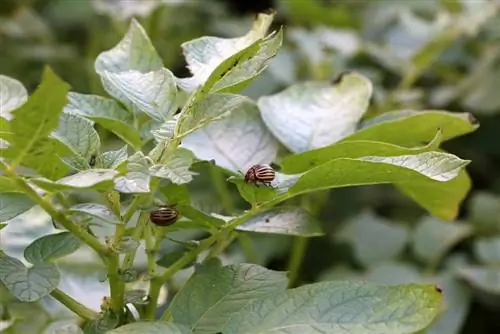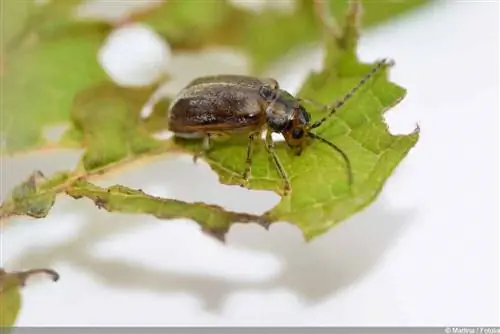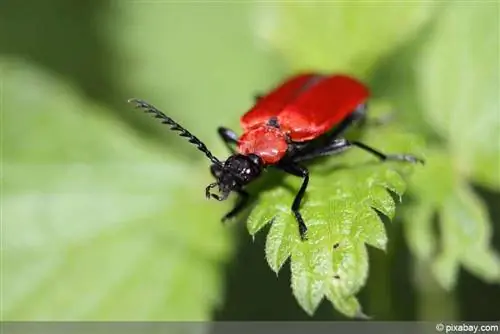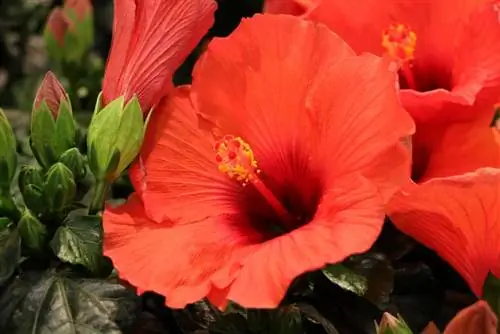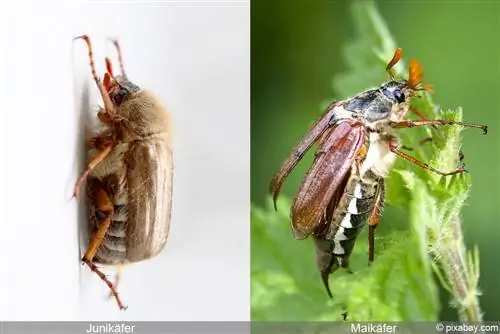- Author admin [email protected].
- Public 2023-12-17 03:39.
- Last modified 2025-01-24 12:45.
Every hobby gardener loves to enjoy the potatoes from their own garden. But there are others who love these potatoes just as much. This also includes the Colorado potato beetle, which can destroy the entire plant and thus also the harvest. Of course, it hardly has any enemies, because its coloring ensures that the enemies keep their distance.
Mixed culture can deter pests
Of course, the Colorado potato beetle could also be controlled with chemical agents, but no one wants to do that in their own garden. Above all, not every remedy is effective because the Colorado potato beetle is already immune to many of them. Genetic plants are supposed to fix this, but some people must have had bad experiences with this. Because more is promised here than the plants can actually deliver. Especially in the case of corn and cotton, these pests are already immune, which then destroys the harvest in the fields. The result is that even more different chemical control agents have to be used, which is neither good for people nor for the environment. Therefore, there are some plants that can help keep the Colorado potato beetle at bay. However, stopping it completely doesn't always work. Changing the cultivation area can also help prevent so many pests from spreading in the garden.
Protecting potato plants
So that there is no infestation with Colorado potato beetles and eggs, a net can keep the pests away. The plants are largely protected, although slight infestation can still occur. There is no ultimate means of preventing an infestation; even chemicals cannot help in the long term. An early potato variety helps ensure that at least the plants are somewhat protected. In addition, you should not fertilize with a nitrogen-containing mineral fertilizer. Although this ensures a higher yield, the plants seem to be less resilient. This is probably due to the rapid growth, which demands a lot of energy from the plants. It is also important that a different location is chosen every year. This prevents the soil from being depleted and larvae that may still be in the soil from finding food straight away.
Natural enemies of the Colorado potato beetle
Of course the Colorado potato beetle also has natural enemies. These include toads, ground beetles and caterpillar flies. However, these alone cannot really destroy all the Colorado potato beetles, but they do help keep the population somewhat under control. Caraway or peppermint is also said to be an effective remedy. Placing these between the potatoes will at least deter some Colorado potato beetles. In addition, both are useful plants and can of course be used in the kitchen. However, the Colorado potato beetle is also said to not like peppermint tea. For this purpose, an infusion of peppermint leaves is brewed. Then drain this broth and spray it on and under the plants. It is important to spray just under the plants so that no larvae can stay here.
Coffee grounds can also help

That sounds pretty unusual, but it should help. Simply collect the coffee grounds and dry them. Then spread this over the leaves. The best time for this is the early morning hours, as there is still dew on the leaves. This way the coffee grounds can settle on them and keep the Colorado potato beetles away. This can be done at a planting height of 10 or 12 cm. Then repeat the whole thing every four to six weeks. Mint can also be planted between the potatoes. However, the mint plants should remain in pots, otherwise the plant will spread unhindered and overgrow the garden. Of course, this is neither intended nor intended. However, all means can only help to keep the plague within limits, because nothing can keep the Colorado potato beetles away from a delicious meal. Even organic farmers know these unpleasant pests too well.
Collect by hand
This sounds tedious, which it is. But this is the only way everyone can be sure that they will actually catch all the Colorado potato beetles. Also remove affected leaves. Simply look under the leaves and carefully pick them off. It's tedious, but it means more potatoes can grow naturally. Above all, this can be done without any chemicals and is therefore an uncontaminated food. However, there is no point in burying the Colorado beetles you have collected, as they feel particularly comfortable in the soil. It's best to dispose of the beetles in the fire or have water in the bucket. This sounds brutal, but otherwise no one will be able to destroy these pests. If you have enough space and no noisy neighbors, you can also keep chickens or geese. These then do the work, as Colorado potato beetles make a delicious meal. It is also important that all measures are carried out as early as possible so that the larvae do not have time to grow.
Biological agents to spray
Often the infestation is so severe that only a spray can help. There are also means for this that are even permitted in organic cultivation. These do not harm livestock such as bees, but are only against Colorado potato beetles. Neem from Scotts Celaflor is worth mentioning because it is made from renewable raw materials. Above all, it is also environmentally friendly, which is not the case with other products. There is also a product from Bayer, but it is not really good for aquatic organisms. It can also only be used in kitchen gardens, which significantly limits its use. All remedies have one thing in common: they must be applied as early as possible in the event of a larval infestation. Otherwise, only good old manual labor will help.
Potato beetles are stubborn

The bottom line is that collecting by hand is still a good solution. However, this is done early in the morning, because the beetles and larvae are not yet very mobile. It is also important that the location for the potato plants is changed annually. This means that larvae that are still in the ground cannot find food directly. Chickens and geese can help, but they can't live everywhere. There is no guarantee, but that is natural.
What you should know about the Colorado potato beetle in brief
- The Colorado potato beetle, like the potato, comes from Colorado.
- The beetle was introduced along with her and spread worldwide.
- Potato beetles and their offspring can devour entire potato fields within a short period of time.
- Her favorite food is parts of potatoes. They are dreaded pests.
- Aside from potatoes, they also eat other nightshade plants, such as tomatoes and tobacco.
- In June, female Colorado potato beetles lay up to 1,200 eggs on the underside of the leaves of the potato plant.
- The voracious larvae hatch after just 3 to 12 days. These eat almost exclusively the leaves of the potato plant.
- In warm years, two generations develop in our part of the world, which can become a real plague.
- Potato beetles are good fliers. That's why they spread quickly from one field to the next.
- The striking stripes of the Colorado potato beetle are a good protection for the insects. They are warning colors. The birds didn't dare to eat the beetles.
- So the Colorado potato beetles had no natural enemies for a long time and were able to reproduce undisturbed.
- It was only in the last few decades that native bird species, such as pheasants, began to adopt the Colorado potato beetle as prey.
- When planting potatoes in your garden, consider planting some caraway plants among them. They don't like Colorado potato beetles.
- Pest protection nets also help. They keep away voracious maggots, caterpillars and beetles.
- Organic farmers can fight Colorado potato beetles with the help of Bacillus thurengiensis.
Bio-Collector against Colorado potato beetle
There are also technical solutions: The bio-collector first blows the beetles and their larvae off the plants and then sucks them into a collecting tray. These tubs can be removed to dispose of the beetles. This device is available in two and four row versions, depending on how large a field is. A hectare can be made beetle-free in an hour. Of course, such a device is not worth it for the hobby gardener. Preventive measures are more suitable.
Unfortunately, the technical aid is no longer offered. But you might be lucky enough to find a copy in the online classifieds
Natural remedies against Colorado potato beetles
To strengthen plants, you can spray with nettle-algae combination and/or rock dust. Spraying nettle and tansy manure is also said to strengthen the plants. Antifungal agents containing copper have a repellent effect on Colorado potato beetles. If you don't have a large cultivated area, you can also collect the beetles. The larvae can also be dusted with rock dust. This is how they are killed.

